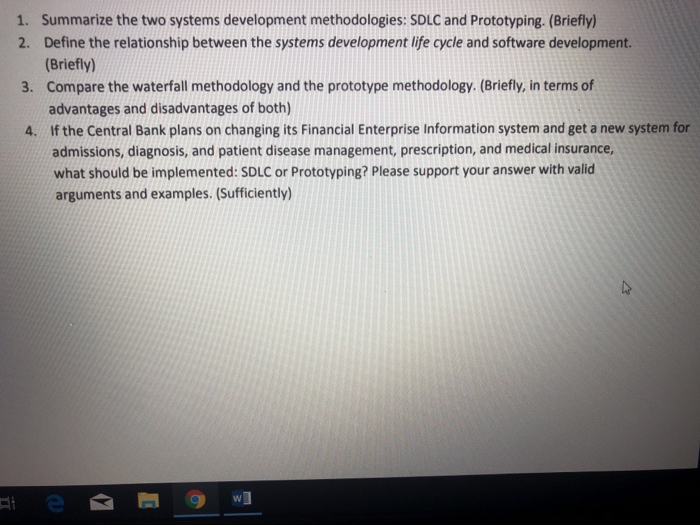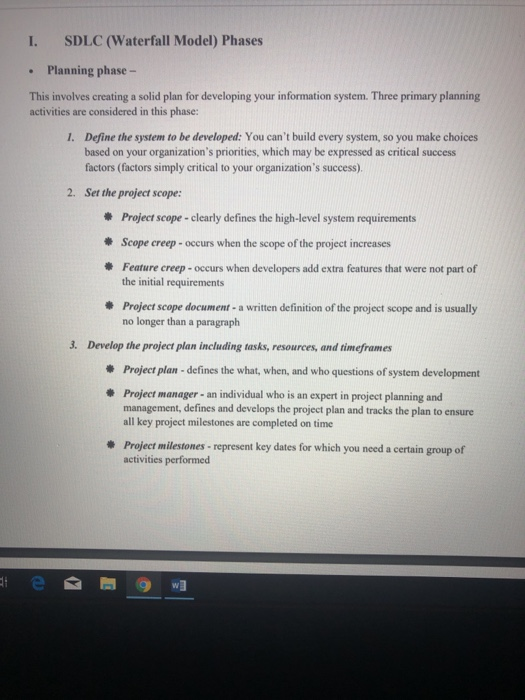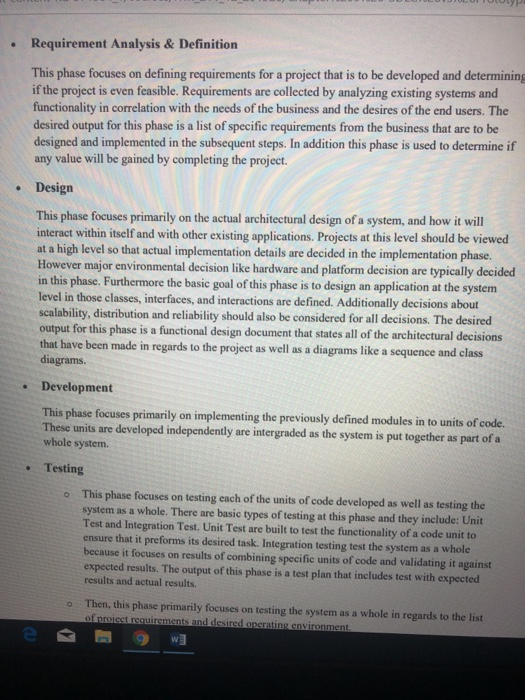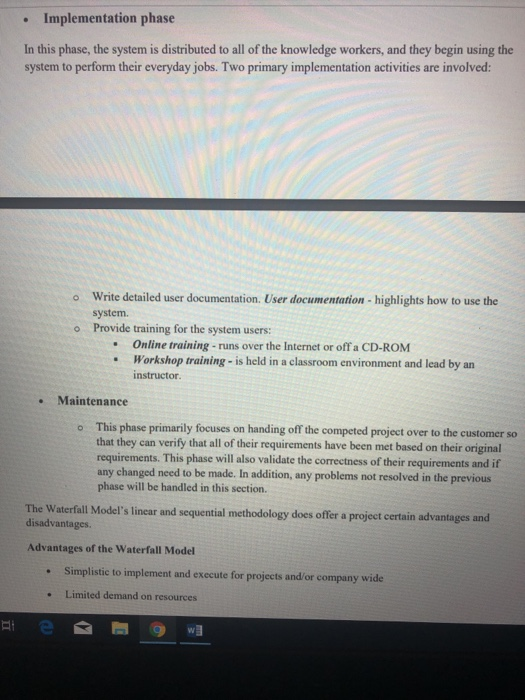[Solved]1 2 Summarize Two Systems Development Methodologies Sdlc Prototyping Briefly Define Relati Q37029583





 1. 2. Summarize the two systems development methodologies: SDLC and Prototyping. (Briefly) Define the relationship between the systems development life cycle and software development. (Briefly) Compare the waterfall methodology and the prototype methodology. (Briefly, in terms of advantages and disadvantages of both) If the Central Bank plans on changing its Financial Enterprise Information system and get a new system for 3. 4. admissions, diagnosis, and patient disease management, prescription, and medical insurance what should be implemented: SDLC or Prototyping? Please support your answer with valid arguments and examples. (Sufficiently) I. SDLC (Waterfall Model) Phases Planning phase- This involves creating a solid plan for developing your information system. Three primary planning activities are considered in this phase: Define the system to be developed: You can’t build every system, so you make choices based on your organization’s priorities, which may be expressed as critical success factors (factors simply critical to your organization’s success). 1. 2. Set the project scope: Project scope – clearly defines the high-level system requirements Scope creep-occurs when the scope of the project increases Feature creep-occurs when developers add extra features that were not part of the initial requirements Project scope document- a written definition of the project scope and is usually no longer than a paragraph Develop the project plan including tasks, resources, and timeframes 3. Project plan-defines the what, when, and who questions of system development Project manager- an individual who is an expert in project planning and management, defines and develops the project plan and tracks the plan to ensure all key project milestones are completed on time Project milestones -represent key dates for which you need a certain group of activities performed Requirement Analysis & Definition This phase focuses on defining requirements for a project that is to be developed and determining if the project is even feasible. Requirements are collected by analyzing existing systems and functionality in correlation with the needs of the business and the desires of the end users. The desired output for this phase is a list of specific requirements from the business that are to be designed and implemented in the subsequent steps. In addition this phase is used to determine if any value will be gained by completing the project. . Design This phase focuses primarily on the actual architectural design of a system, and how it will interact within itself and with other existing applications. Projects at this level should be viewed at a high level so that actual implementation details are decided in the implementation phase. However major environmental decision like hardware and platform decision are typically decided in this phase. Furthermore the basic goal of this phase is to design an application at the system level in those classes, interfaces, and interactions are defined. Additionally decisions about scalability, distribution and reliability should also be considered for all decisions. The desired output for this phase is a functional design document that states all of the architectural decisions that have been made in regards to the project as well as a diagrams like a sequence and class diagrams. . Development This phase focuses primarily on implementing the previously defined modules in to units of code. These units are developed independently are intergraded as the system is put together as part of a whole system. Testing This phase focuses on testing each of the units of code developed as well as testing the system as a whole. There are basic types of testing at this phase and they include: Unit Test and Integration Test. Unit Test are built to test the functionality of a code unit to ensure that it preforms its desired task. Integration testing test the system as a whole because it focuses on results of combining specific units of code and validating it against expected results. The output of this phase is a test plan that includes test with expected results and actual results. Then, this phase primarily focuses on testing the system as a whole in regards to the list o Implementation phase In this phase, the system is distributed to all of the knowledge workers, and they begin using the system to perform their everyday jobs. Two primary implementation activities are involved: Write detailed user documentation. User documentation-highlights how to use the system. Provide training for the system users: o o Online training- runs over the Internet or off a CD-ROM Workshop training – is held in a classroom environment and lead by an instructor Maintenance This phase primarily focuses on handing off the competed project over to the customer so that they can verify that all of their requirements have been met based on their original requirements. This phase will also validate the correctness of their requirements and if any changed need to be made. In addition, any problems not resolved in the previous phase will be handled in this section. o The Waterfall Model’s linear and sequential methodology does offer a project certain advantages and disadvantages. Advantages of the Waterfall Model Simplistic to implement and execute for projects and/or company wide Limited demand on resources %20 Prototyping pdf 62099620-SOC%20 1 2 20 1920 Chapte ntent rid 971 984 1/courses IIM 2 1 1 Large emphasis on documentation 31 571 3-di . Disadvantages of the Waterfall Model Completed phases cannot be revisited regardless if issues arise within a project Accurate requirements are never gathered prior to the completion of the requirement phase due to the lack of clarification in regards to client’s desires. . Small changes or errors that arise in applications may cause additional problems The client cannot change any requirements once the requirements phase has been completed leaving them no options for changes as they see their requirements change as the customers desires change. . Excess documentation Phases are cumbersome and slow moving Prototyping Conversely, the Hare shares similar traits with the prototyping software development model in that ideas are rapidly converted to basic working examples and subsequent changes are made to quickly align the projeet with customers desires as they are formulated and as software strays from the customers vision. The basic concept of prototyping is to eliminate the use of well-defined project requirements. Projects are allowed to grow as the customer needs and requests grow. Projects are initially designed according to basic requirements and are refined as requirement become more refined. This process allows cus feel their way around the application to ensure that they are developing exactly what they want in the application This model also works well for determining the feasibility of certain approaches in regards to an application. Prototypes allow for quickly developing examples of implementing specific functionality based on certain techniques. Advantages of Prototyping Active participation from users and customers .Allows customers to change their mind in specifying requirements Customers get a better understanding of the system as it is developed Earlier bug/error detection Promotes communication with customers Prototype could be used as final production . Reduced time needed to develop applications compared to the Waterfall method Disadvantages of Prototyping Promotes constantly redefining project requirements that cause major system rewrites Potential for increased complexity of a system as scope of the system expands Customer could believe the prototype as the working version. Implementation compromises could increase the complexity when applying updates and or application fixes When companies try to decide between the Waterfall model and Prototype model they need to evaluate the benefits and disadvantages for both models. Typically smaller companies or projects that have major time constraints typically head for more of a Prototype model approach because it can reduce the time needed to complete the project because there is more of a focus on building a project and less on defining requirements and scope prior to the start of a project. On the other hand, Companies with well-defined requirements and time allowed to generate proper documentation should steer towards more of a waterfall model because they are in a position to obtain clarified requirements and have to design and optimal solution prior to the start of coding on a project Show transcribed image text 1. 2. Summarize the two systems development methodologies: SDLC and Prototyping. (Briefly) Define the relationship between the systems development life cycle and software development. (Briefly) Compare the waterfall methodology and the prototype methodology. (Briefly, in terms of advantages and disadvantages of both) If the Central Bank plans on changing its Financial Enterprise Information system and get a new system for 3. 4. admissions, diagnosis, and patient disease management, prescription, and medical insurance what should be implemented: SDLC or Prototyping? Please support your answer with valid arguments and examples. (Sufficiently)
1. 2. Summarize the two systems development methodologies: SDLC and Prototyping. (Briefly) Define the relationship between the systems development life cycle and software development. (Briefly) Compare the waterfall methodology and the prototype methodology. (Briefly, in terms of advantages and disadvantages of both) If the Central Bank plans on changing its Financial Enterprise Information system and get a new system for 3. 4. admissions, diagnosis, and patient disease management, prescription, and medical insurance what should be implemented: SDLC or Prototyping? Please support your answer with valid arguments and examples. (Sufficiently) I. SDLC (Waterfall Model) Phases Planning phase- This involves creating a solid plan for developing your information system. Three primary planning activities are considered in this phase: Define the system to be developed: You can’t build every system, so you make choices based on your organization’s priorities, which may be expressed as critical success factors (factors simply critical to your organization’s success). 1. 2. Set the project scope: Project scope – clearly defines the high-level system requirements Scope creep-occurs when the scope of the project increases Feature creep-occurs when developers add extra features that were not part of the initial requirements Project scope document- a written definition of the project scope and is usually no longer than a paragraph Develop the project plan including tasks, resources, and timeframes 3. Project plan-defines the what, when, and who questions of system development Project manager- an individual who is an expert in project planning and management, defines and develops the project plan and tracks the plan to ensure all key project milestones are completed on time Project milestones -represent key dates for which you need a certain group of activities performed Requirement Analysis & Definition This phase focuses on defining requirements for a project that is to be developed and determining if the project is even feasible. Requirements are collected by analyzing existing systems and functionality in correlation with the needs of the business and the desires of the end users. The desired output for this phase is a list of specific requirements from the business that are to be designed and implemented in the subsequent steps. In addition this phase is used to determine if any value will be gained by completing the project. . Design This phase focuses primarily on the actual architectural design of a system, and how it will interact within itself and with other existing applications. Projects at this level should be viewed at a high level so that actual implementation details are decided in the implementation phase. However major environmental decision like hardware and platform decision are typically decided in this phase. Furthermore the basic goal of this phase is to design an application at the system level in those classes, interfaces, and interactions are defined. Additionally decisions about scalability, distribution and reliability should also be considered for all decisions. The desired output for this phase is a functional design document that states all of the architectural decisions that have been made in regards to the project as well as a diagrams like a sequence and class diagrams. . Development This phase focuses primarily on implementing the previously defined modules in to units of code. These units are developed independently are intergraded as the system is put together as part of a whole system. Testing This phase focuses on testing each of the units of code developed as well as testing the system as a whole. There are basic types of testing at this phase and they include: Unit Test and Integration Test. Unit Test are built to test the functionality of a code unit to ensure that it preforms its desired task. Integration testing test the system as a whole because it focuses on results of combining specific units of code and validating it against expected results. The output of this phase is a test plan that includes test with expected results and actual results. Then, this phase primarily focuses on testing the system as a whole in regards to the list o Implementation phase In this phase, the system is distributed to all of the knowledge workers, and they begin using the system to perform their everyday jobs. Two primary implementation activities are involved: Write detailed user documentation. User documentation-highlights how to use the system. Provide training for the system users: o o Online training- runs over the Internet or off a CD-ROM Workshop training – is held in a classroom environment and lead by an instructor Maintenance This phase primarily focuses on handing off the competed project over to the customer so that they can verify that all of their requirements have been met based on their original requirements. This phase will also validate the correctness of their requirements and if any changed need to be made. In addition, any problems not resolved in the previous phase will be handled in this section. o The Waterfall Model’s linear and sequential methodology does offer a project certain advantages and disadvantages. Advantages of the Waterfall Model Simplistic to implement and execute for projects and/or company wide Limited demand on resources %20 Prototyping pdf 62099620-SOC%20 1 2 20 1920 Chapte ntent rid 971 984 1/courses IIM 2 1 1 Large emphasis on documentation 31 571 3-di . Disadvantages of the Waterfall Model Completed phases cannot be revisited regardless if issues arise within a project Accurate requirements are never gathered prior to the completion of the requirement phase due to the lack of clarification in regards to client’s desires. . Small changes or errors that arise in applications may cause additional problems The client cannot change any requirements once the requirements phase has been completed leaving them no options for changes as they see their requirements change as the customers desires change. . Excess documentation Phases are cumbersome and slow moving Prototyping Conversely, the Hare shares similar traits with the prototyping software development model in that ideas are rapidly converted to basic working examples and subsequent changes are made to quickly align the projeet with customers desires as they are formulated and as software strays from the customers vision. The basic concept of prototyping is to eliminate the use of well-defined project requirements. Projects are allowed to grow as the customer needs and requests grow. Projects are initially designed according to basic requirements and are refined as requirement become more refined. This process allows cus feel their way around the application to ensure that they are developing exactly what they want in the application This model also works well for determining the feasibility of certain approaches in regards to an application. Prototypes allow for quickly developing examples of implementing specific functionality based on certain techniques. Advantages of Prototyping Active participation from users and customers .Allows customers to change their mind in specifying requirements Customers get a better understanding of the system as it is developed Earlier bug/error detection Promotes communication with customers Prototype could be used as final production . Reduced time needed to develop applications compared to the Waterfall method Disadvantages of Prototyping Promotes constantly redefining project requirements that cause major system rewrites Potential for increased complexity of a system as scope of the system expands Customer could believe the prototype as the working version. Implementation compromises could increase the complexity when applying updates and or application fixes When companies try to decide between the Waterfall model and Prototype model they need to evaluate the benefits and disadvantages for both models. Typically smaller companies or projects that have major time constraints typically head for more of a Prototype model approach because it can reduce the time needed to complete the project because there is more of a focus on building a project and less on defining requirements and scope prior to the start of a project. On the other hand, Companies with well-defined requirements and time allowed to generate proper documentation should steer towards more of a waterfall model because they are in a position to obtain clarified requirements and have to design and optimal solution prior to the start of coding on a project Show transcribed image text 1. 2. Summarize the two systems development methodologies: SDLC and Prototyping. (Briefly) Define the relationship between the systems development life cycle and software development. (Briefly) Compare the waterfall methodology and the prototype methodology. (Briefly, in terms of advantages and disadvantages of both) If the Central Bank plans on changing its Financial Enterprise Information system and get a new system for 3. 4. admissions, diagnosis, and patient disease management, prescription, and medical insurance what should be implemented: SDLC or Prototyping? Please support your answer with valid arguments and examples. (Sufficiently)
I. SDLC (Waterfall Model) Phases Planning phase- This involves creating a solid plan for developing your information system. Three primary planning activities are considered in this phase: Define the system to be developed: You can’t build every system, so you make choices based on your organization’s priorities, which may be expressed as critical success factors (factors simply critical to your organization’s success). 1. 2. Set the project scope: Project scope – clearly defines the high-level system requirements Scope creep-occurs when the scope of the project increases Feature creep-occurs when developers add extra features that were not part of the initial requirements Project scope document- a written definition of the project scope and is usually no longer than a paragraph Develop the project plan including tasks, resources, and timeframes 3. Project plan-defines the what, when, and who questions of system development Project manager- an individual who is an expert in project planning and management, defines and develops the project plan and tracks the plan to ensure all key project milestones are completed on time Project milestones -represent key dates for which you need a certain group of activities performed
Requirement Analysis & Definition This phase focuses on defining requirements for a project that is to be developed and determining if the project is even feasible. Requirements are collected by analyzing existing systems and functionality in correlation with the needs of the business and the desires of the end users. The desired output for this phase is a list of specific requirements from the business that are to be designed and implemented in the subsequent steps. In addition this phase is used to determine if any value will be gained by completing the project. . Design This phase focuses primarily on the actual architectural design of a system, and how it will interact within itself and with other existing applications. Projects at this level should be viewed at a high level so that actual implementation details are decided in the implementation phase. However major environmental decision like hardware and platform decision are typically decided in this phase. Furthermore the basic goal of this phase is to design an application at the system level in those classes, interfaces, and interactions are defined. Additionally decisions about scalability, distribution and reliability should also be considered for all decisions. The desired output for this phase is a functional design document that states all of the architectural decisions that have been made in regards to the project as well as a diagrams like a sequence and class diagrams. . Development This phase focuses primarily on implementing the previously defined modules in to units of code. These units are developed independently are intergraded as the system is put together as part of a whole system. Testing This phase focuses on testing each of the units of code developed as well as testing the system as a whole. There are basic types of testing at this phase and they include: Unit Test and Integration Test. Unit Test are built to test the functionality of a code unit to ensure that it preforms its desired task. Integration testing test the system as a whole because it focuses on results of combining specific units of code and validating it against expected results. The output of this phase is a test plan that includes test with expected results and actual results. Then, this phase primarily focuses on testing the system as a whole in regards to the list o
Implementation phase In this phase, the system is distributed to all of the knowledge workers, and they begin using the system to perform their everyday jobs. Two primary implementation activities are involved: Write detailed user documentation. User documentation-highlights how to use the system. Provide training for the system users: o o Online training- runs over the Internet or off a CD-ROM Workshop training – is held in a classroom environment and lead by an instructor Maintenance This phase primarily focuses on handing off the competed project over to the customer so that they can verify that all of their requirements have been met based on their original requirements. This phase will also validate the correctness of their requirements and if any changed need to be made. In addition, any problems not resolved in the previous phase will be handled in this section. o The Waterfall Model’s linear and sequential methodology does offer a project certain advantages and disadvantages. Advantages of the Waterfall Model Simplistic to implement and execute for projects and/or company wide Limited demand on resources
%20 Prototyping pdf 62099620-SOC%20 1 2 20 1920 Chapte ntent rid 971 984 1/courses IIM 2 1 1 Large emphasis on documentation 31 571 3-di . Disadvantages of the Waterfall Model Completed phases cannot be revisited regardless if issues arise within a project Accurate requirements are never gathered prior to the completion of the requirement phase due to the lack of clarification in regards to client’s desires. . Small changes or errors that arise in applications may cause additional problems The client cannot change any requirements once the requirements phase has been completed leaving them no options for changes as they see their requirements change as the customers desires change. . Excess documentation Phases are cumbersome and slow moving Prototyping Conversely, the Hare shares similar traits with the prototyping software development model in that ideas are rapidly converted to basic working examples and subsequent changes are made to quickly align the projeet with customers desires as they are formulated and as software strays from the customers vision. The basic concept of prototyping is to eliminate the use of well-defined project requirements. Projects are allowed to grow as the customer needs and requests grow. Projects are initially designed according to basic requirements and are refined as requirement become more refined. This process allows cus feel their way around the application to ensure that they are developing exactly what they want in the application
This model also works well for determining the feasibility of certain approaches in regards to an application. Prototypes allow for quickly developing examples of implementing specific functionality based on certain techniques. Advantages of Prototyping Active participation from users and customers .Allows customers to change their mind in specifying requirements Customers get a better understanding of the system as it is developed Earlier bug/error detection Promotes communication with customers Prototype could be used as final production . Reduced time needed to develop applications compared to the Waterfall method Disadvantages of Prototyping Promotes constantly redefining project requirements that cause major system rewrites Potential for increased complexity of a system as scope of the system expands Customer could believe the prototype as the working version. Implementation compromises could increase the complexity when applying updates and or application fixes When companies try to decide between the Waterfall model and Prototype model they need to evaluate the benefits and disadvantages for both models. Typically smaller companies or projects that have major time constraints typically head for more of a Prototype model approach because it can reduce the time needed to complete the project because there is more of a focus on building a project and less on defining requirements and scope prior to the start of a project. On the other hand, Companies with well-defined requirements and time allowed to generate proper documentation should steer towards more of a waterfall model because they are in a position to obtain clarified requirements and have to design and optimal solution prior to the start of coding on a project
Expert Answer
Answer to 1. 2. Summarize the two systems development methodologies: SDLC and Prototyping. (Briefly) Define the relationship betwe… . . .
OR

